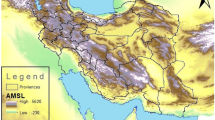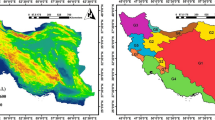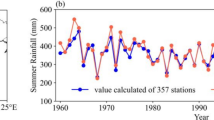Abstract
Since investigating the long-term trends of the renewable energy potential may help in planning sustainable energy systems, this study intends to forecast the renewable energy potential of the East Thrace, Turkey region, in the future based on CMIP6 Global Circulation Models data using the ensemble mean output of the best-performed tree-based machine learning method. To evaluate the accuracy of global circulation models, Kling-Gupta efficiency, modified index of agreement, and normalized root-mean-square error are applied. The best four global circulation models are detected as a result of the comprehensive rating metric, which combines all accuracy performance results into a single metric. Three different machine learning methods, random forest, gradient boosting regression tree, and extreme gradient boosting, are trained using the historical data of the top-four global circulation models and the ERA5 dataset to calculate the multi-model ensembles of each climate variable, and then, the future trends of those variables are forecasted based on the output of ensemble means of best-performed machine learning methods with the lowest out-of-bag root-mean-square error. It is foreseen that there will not be a significant change in the wind power density. The annual average solar energy output potential is found to be between 237.8 and 240.7 kWh/m2/year depending on the shared socioeconomic pathway scenario. Under the forecasted precipitation scenarios, 356–362 l/m2/year of irrigation water could be harvested from agrivoltaic systems. Thereby, it would be possible to grow crops, generate electricity, and harvest rainwater on the same area. Furthermore, tree-based machine learning methods provide much lower error compared to simple mean methods.






Similar content being viewed by others
Data availability
The datasets generated during and/or analysed during the current study are available from the corresponding author on reasonable request.
Code availability
The codes generated during the current study are available from the corresponding author on reasonable request.
Abbreviations
- ANN:
-
Artificial neural network
- CMIP:
-
Coupled Model Intercomparison Project
- CPU:
-
Graphics processing unit
- DNN:
-
Deep neural network
- ETR:
-
Extra tree regressor
- GBRT:
-
Gradient boosting regression tree
- GCM:
-
Global circulation model
- GHG:
-
Greenhouse gas
- KGE:
-
Kling-Gupta efficiency
- KNN:
-
K-Nearest neighbour
- LOESS:
-
Locally estimated scatterplot smoothing
- LSTM:
-
Long-short term memory
- md:
-
Modified index of agreement
- ML:
-
Machine learning
- MLR:
-
Multiple linear regression
- MME:
-
Multi-model ensemble
- MR:
-
Comprehensive rating metric
- NN:
-
Neural network
- nRMSE:
-
Normalized root-mean-square error
- OLS:
-
Ordinary least square
- PV:
-
Photovoltaic
- RES:
-
Renewable energy sources
- RF:
-
Random forest
- RMSE:
-
Root-mean-square error
- RVM:
-
Relevance vector machine
- SM:
-
Simple mean
- SSP:
-
Shared socioeconomic pathways
- SVM:
-
Support vector machine
- WPD:
-
Wind power density
References
Acharya N, Shrivastava NA, Panigrahi BK, Mohanty UC (2014) Development of an artificial neural network based multi-model ensemble to estimate the northeast monsoon rainfall over south peninsular India: an application of extreme learning machine. Clim Dyn 43(5):1303–1310. https://doi.org/10.1007/s00382-013-1942-2
Ahmed K, Sachindra DA, Shahid S, Demirel MC, Chung ES (2019) Selection of multi-model ensemble of general circulation models for the simulation of precipitation and maximum and minimum temperature based on spatial assessment metrics. Hydrol Earth Syst Sci 23(11):4803–4824. https://doi.org/10.5194/hess-23-4803-2019
Ahmed K, Sachindra DA, Shahid S, Iqbal Z, Nawaz N, Khan N (2020) Multi-model ensemble predictions of precipitation and temperature using machine learning algorithms. Atmos Res 236:104806. https://doi.org/10.1016/j.atmosres.2019.104806
Ahsan S, Bhat MS, Alam A, Farooq H, Shiekh HA (2022) Complementary use of multi-model climate ensemble and Bayesian model averaging for projecting river hydrology in the Himalaya. Environ Sci Pollut Res 1–23. https://doi.org/10.1007/s11356-022-24913-6
Akinsanola AA, Zhou W (2019) Projections of West African summer monsoon rainfall extremes from two CORDEX models. Clim Dyn 52(3):2017–2028. https://doi.org/10.1007/s00382-018-4238-8
Akinsanola AA, Ogunjobi KO, Abolude AT, Salack S (2021) Projected changes in wind speed and wind energy potential over West Africa in CMIP6 models. Environ Res Lett 16(4):044033. https://doi.org/10.1088/1748-9326/abed7a
Asadollah SBHS, Sharafati A, Shahid S (2022) Application of ensemble machine learning model in downscaling and projecting climate variables over different climate regions in Iran. Environ Sci Pollut Res 29(12):17260–17279. https://doi.org/10.1007/s11356-021-16964-y
Bojer CS, Meldgaard JP (2021) Kaggle forecasting competitions: an overlooked learning opportunity. Int J Forecast 37(2):587–603. https://doi.org/10.1016/j.ijforecast.2020.07.007
Breiman L (2001) Random forests. Machine Learning 45(1):5–32
Brown C, Brown E, Murray-Rust D, Cojocaru G, Savin C, Rounsevell M (2015) Analysing uncertainties in climate change impact assessment across sectors and scenarios. Clim Change 128(3):293–306. https://doi.org/10.1007/s10584-014-1133-0
Camargo LR, Zink R, Dorner W, Stoeglehner G (2015) Spatio-temporal modeling of roof-top photovoltaic panels for improved technical potential assessment and electricity peak load offsetting at the municipal scale. Comput Environ Urban Syst 52:58–69. https://doi.org/10.1016/j.compenvurbsys.2015.03.002
Carvalho D, Rocha A, Costoya X, DeCastro M, Gómez-Gesteira M (2021) Wind energy resource over Europe under CMIP6 future climate projections: what changes from CMIP5 to CMIP6. Renew Sustain Energy Rev 151:111594. https://doi.org/10.1016/j.rser.2021.111594
Chen FW, Liu CW (2012) Estimation of the spatial rainfall distribution using inverse distance weighting (IDW) in the middle of Taiwan. Paddy Water Environ, 10(3):209–222. https://doi.org/10.1007/s10333-012-0319-1
Demircan M, Gürkan H, Eskioğlu O, Arabacı H, Coşkun M (2017) Climate change projections for Turkey: three models and two scenarios. Turkish J Water Sci Manag 1(1):22–43. https://doi.org/10.31807/tjwsm.297183
de Jong P, Barreto TB, Tanajura CA, Kouloukoui D, Oliveira-Esquerre KP, Kiperstok A, Torres EA (2019) Estimating the impact of climate change on wind and solar energy in Brazil using a South American regional climate model. Renew Energy 141:390–401. https://doi.org/10.1016/j.renene.2019.03.086
Dey A, Sahoo DP, Kumar R, Remesan R (2022) A multimodel ensemble machine learning approach for CMIP6 climate model projections in an Indian River basin. Int J Climatol 1–22. https://doi.org/10.1002/joc.7813
Dubey S, Sarvaiya JN, Seshadri B (2013) Temperature dependent photovoltaic (PV) efficiency and its effect on PV production in the world–a review. Energy Procedia 33:311–321. https://doi.org/10.1016/j.egypro.2013.05.072
Dutta R, Chanda K, Maity R (2022) Future of solar energy potential in a changing climate across the world: a CMIP6 multi-model ensemble analysis. Renew Energy 188:819–829. https://doi.org/10.1016/j.renene.2022.02.023
EMBER (2022) Global Electricity Review 2022. https://ember-climate.org/app/uploads/2022/03/Report-GER22.pdf. Accessed 23 Sept 2022
Emeis S (2018) Wind energy meteorology: atmospheric physics for wind power generation. Springer Berlin. https://doi.org/10.1007/978-3-319-72859-9
Energy Atlas (2022a) Turkey Wind Energy Potential Map. https://www.enerjiatlasi.com/ruzgar-enerjisi-haritasi/turkiye. Accessed on28 Sept 2022a
Energy Atlas (2022b) Turkey Solar Energy Potential Map. https://www.enerjiatlasi.com/gunes-enerjisi-haritasi/turkiye. Accessed on 28 Sept 2022b
Essenfelder AH, Giupponi C (2020) A coupled hydrologic-machine learning modelling framework to support hydrologic modelling in river basins under interbasin water transfer regimes. Environ Model Softw 131:104779. https://doi.org/10.1016/j.envsoft.2020.104779
Eyring V, Bony S, Meehl GA, Senior CA, Stevens B, Stouffer RJ, Taylor KE (2016) Overview of the Coupled Model Intercomparison Project Phase 6 (CMIP6) experimental design and organization. Geosci Model Dev 9(5):1937–1958. https://doi.org/10.5194/gmd-9-1937-2016
[dataset] EXIST- Energy Exchange Istanbul. (2023) Real Time Generation: 01.01.2022–31.12.2022. https://seffaflik.epias.com.tr/transparency/uretim/gerceklesen-uretim/gercek-zamanli-uretim.xhtml. Accessed on 21 May 2023
Fan J, Wang X, Wu L, Zhou H, Zhang F, Yu X, Xiang Y (2018) Comparison of support vector machine and extreme gradient boosting for predicting daily global solar radiation using temperature and precipitation in humid subtropical climates: a case study in China. Energy Convers Manag 164:102–111. https://doi.org/10.1016/j.enconman.2018.02.087
Gönül Ö, Duman AC, Deveci K, Güler Ö (2021) An assessment of wind energy status, incentive mechanisms and market in Turkey. Eng Sci Technol Int J 24(6):1383–1395. https://doi.org/10.1016/j.jestch.2021.03.016
Gupta HV, Kling H, Yilmaz KK, Martinez GF (2009) Decomposition of the mean squared error and NSE performance criteria: Implications for improving hydrological modelling. J Hydrol 377(1–2):80–91. https://doi.org/10.1016/j.jhydrol.2009.08.003
Guven D, Ozozen A, Kayakutlu G, Kayalica MO (2021) Predicting power deviation in the Turkish power market based on adaptive factor impacts. In: Mercier-Laurent E, Kayalica MÖ, Owoc ML (ed) Artificial Intelligence for Knowledge Management. AI4KM 2021. IFIP Advances in Information and Communication Technology, vol 614. Springer, Cham, pp 213–234. https://doi.org/10.1007/978-3-030-80847-1_14
Homsi R, Shiru MS, Shahid S, Ismail T, Harun SB, Al-Ansari N et al (2020) Precipitation projection using a CMIP5 GCM ensemble model: a regional investigation of Syria. Eng Appl Comput Fluid Mech 14(1):90–106. https://doi.org/10.1080/19942060.2019.1683076
IEA- International Energy Agency (2022) Key energy statistics: electricity generation by source (Turkey). https://www.iea.org/countries/turkey. Accessed 21 Sept 2022
Iqbal Z, Shahid S, Ahmed K, Ismail T, Khan N, Virk ZT, Johar W (2020) Evaluation of global climate models for precipitation projection in sub-Himalaya region of Pakistan. Atmos Res 245:105061. https://doi.org/10.1016/j.atmosres.2020.105061
Jose DM, Vincent AM, Dwarakish GS (2022) Improving multiple model ensemble predictions of daily precipitation and temperature through machine learning techniques. Sci Rep 12(1):1–25. https://doi.org/10.1038/s41598-022-08786-w
Kundzewicz ZW, Krysanova V, Benestad RE, Hov Ø, Piniewski M, Otto IM (2018) Uncertainty in climate change impacts on water resources. Environ Sci Policy 79:1–8. https://doi.org/10.1016/j.envsci.2017.10.008
Luderer G, Krey V, Calvin K, Merrick J, Mima S, Pietzcker R et al (2014) The role of renewable energy in climate stabilization: results from the EMF27 scenarios. Clim Change 123(3):427–441. https://doi.org/10.1007/s10584-013-0924-z
Lundberg SM, Erion G, Chen H, DeGrave A, Prutkin JM, Nair B, Lee SI (2020) From local explanations to global understanding with explainable AI for trees. Nat Mach Intell 2(1):56–67. https://doi.org/10.1038/s42256-019-0138-9
Malik P, Awasthi M, Upadhyay S, Agrawal P, Raina G, Sharma S, Sinha S (2023) Planning and optimization of sustainable grid integrated hybrid energy system in India. Sustain Energy Technol Assess 56:103115. https://doi.org/10.1016/j.seta.2023.103115
Marvin D, Nespoli L, Strepparava D, Medici V (2022) A data-driven approach to forecasting ground-level ozone concentration. Int J Forecast 38(3):970–987. https://doi.org/10.1016/j.ijforecast.2021.07.008
MENR- Ministry of Energy and Natural Resources (2023). Renewable energy. https://enerji.gov.tr/eigm-resources-en Accessed 21 May 2023
Mohammadi K, Shamshirband S, Anisi MH, Alam KA, Petković D (2015) Support vector regression based prediction of global solar radiation on a horizontal surface. Energy Convers Manage 91:433–441. https://doi.org/10.1016/j.enconman.2014.12.015
Noor M, Ismail TB, Shahid S, Ahmed K, Chung ES, Nawaz N (2019) Selection of CMIP5 multi-model ensemble for the projection of spatial and temporal variability of rainfall in peninsular Malaysia. Theoret Appl Climatol 138(1):999–1012. https://doi.org/10.1007/s00704-019-02874-0
Pour SH, Shahid S, Chung ES, Wang XJ (2018) Model output statistics downscaling using support vector machine for the projection of spatial and temporal changes in rainfall of Bangladesh. Atmos Res 213:149–162. https://doi.org/10.1016/j.atmosres.2018.06.006
Prodhan FA, Zhang J, Sharma TPP, Nanzad L, Zhang D, Seka AM et al (2022) Projection of future drought and its impact on simulated crop yield over South Asia using ensemble machine learning approach. Sci Total Environ 807:151029. https://doi.org/10.1016/j.scitotenv.2021.151029
Raju KS, Kumar DN (2020) Review of approaches for selection and ensembling of GCMs. J Water Clim Change 11(3):577–599. https://doi.org/10.2166/wcc.2020.128
Santra P, Singh RK, Meena HM, Kumawat RN, Mishra D, Machiwal D, ... Yadav OP (2020) Agri-voltaic system for crop production and electricity generation from a single land unit. In Advances in energy research, Vol. 1: Selected Papers from ICAER 2017 (pp. 45–56). Singapore: Springer. https://doi.org/10.1007/978-981-15-2666-4_6
Sawadogo W, Abiodun BJ, Okogbue EC (2019) Projected changes in wind energy potential over West Africa under the global warming of 1.5° C and above. Theor Appl Climatol 138(1):321–333. https://doi.org/10.1007/s00704-019-02826-8
StBA- Statistisches Bundesamt (Federal Statistical Office) (2022). Pressrelease #N 037. https://www.destatis.de/EN/Press/2022/06/PE22_N037_43.html. Accessed 28 Sept 2022
Taylor KE, Stouffer RJ, Meehl GA (2012) An overview of CMIP5 and the experiment design. Bull Am Meteor Soc 93(4):485–498. https://doi.org/10.1175/BAMS-D-11-00094.1
Tegegne G, Melesse AM, Worqlul AW (2020) Development of multi-model ensemble approach for enhanced assessment of impacts of climate change on climate extremes. Sci Total Environ 704:135357. https://doi.org/10.1016/j.scitotenv.2019.135357
Wang H, Wang L, Yan G, Bai H, Zhao Y, Ju M et al (2022) Assessment and prediction of extreme temperature indices in the North China Plain by CMIP6 Climate model. Appl Sci 12(14):7201. https://doi.org/10.3390/app12147201
Willmott CJ (1981) On the validation of models. Phys Geogr 2(2):184–194. https://doi.org/10.1080/02723646.1981.10642213
Xu L, Chen N, Zhang X, Chen Z, Hu C, Wang C (2019) Improving the North American multi-model ensemble (NMME) precipitation forecasts at local areas using wavelet and machine learning. Clim Dyn 53(1):601–615. https://doi.org/10.1007/s00382-018-04605-z
Xu R, Chen N, Chen Y, Chen Z (2020) Downscaling and projection of multi-cmip5 precipitation using machine learning methods in the upper han river Basin. Adv Meteorol. https://doi.org/10.1155/2020/8680436
Yan Y, Wang H, Li G, Xia J, Ge F, Zeng Q et al (2022) Projection of future extreme precipitation in China based on the CMIP6 from a machine learning perspective. Remote Sens 14(16):4033. https://doi.org/10.3390/rs14164033
Yilmaz YA, Sen OL, Turuncoglu UU (2019) Modeling the hydroclimatic effects of local land use and land cover changes on the water budget in the upper Euphrates-Tigris basin. J Hydrol 576:596–609. https://doi.org/10.1016/j.jhydrol.2019.06.074
You Q, Jiang Z, Wang D, Pepin N, Kang S (2018) Simulation of temperature extremes in the Tibetan Plateau from CMIP5 models and comparison with gridded observations. Climate Dynamics 51:355–369. https://doi.org/10.1007/s00382-017-3928-y
Zaherpour J, Mount N, Gosling SN, Dankers R, Eisner S, Gerten D, ... Wada Y (2019) Exploring the value of machine learning for weighted multi-model combination of an ensemble of global hydrological models. Environ Model Softw 114: 112–128. https://doi.org/10.1016/j.envsoft.2019.01.003
Zhang P, Lu J, Chen X (2022) Machine-learning ensembled CMIP6 projection reveals socio-economic pathways will aggravate global warming and precipitation extreme. Hydrol Earth Syst Sci Discuss 1-40. https://doi.org/10.5194/hess-2022-235
Zhang Y, Haghani A (2015) A gradient boosting method to improve travel time prediction. Transp Res Part C: Emerg Technol 58:308–324. https://doi.org/10.1016/j.trc.2015.02.019
Author information
Authors and Affiliations
Contributions
Denizhan Guven: conceptualization, methodology, formal analysis, data curation, visualization, writing.
Corresponding author
Ethics declarations
Ethics approval
This material is the author’s own original work, which has not been previously published elsewhere. The paper is not currently being considered for publication elsewhere.
Consent to participate
Not applicable.
Consent for publication
Not applicable.
Competing interests
The author declares no competing interests.
Additional information
Responsible Editor: Marcus Schulz
Publisher's note
Springer Nature remains neutral with regard to jurisdictional claims in published maps and institutional affiliations.
Appendix
Rights and permissions
Springer Nature or its licensor (e.g. a society or other partner) holds exclusive rights to this article under a publishing agreement with the author(s) or other rightsholder(s); author self-archiving of the accepted manuscript version of this article is solely governed by the terms of such publishing agreement and applicable law.
About this article
Cite this article
Guven, D. Development of multi-model ensembles using tree-based machine learning methods to assess the future renewable energy potential: case of the East Thrace, Turkey. Environ Sci Pollut Res 30, 87314–87329 (2023). https://doi.org/10.1007/s11356-023-28649-9
Received:
Accepted:
Published:
Issue Date:
DOI: https://doi.org/10.1007/s11356-023-28649-9




